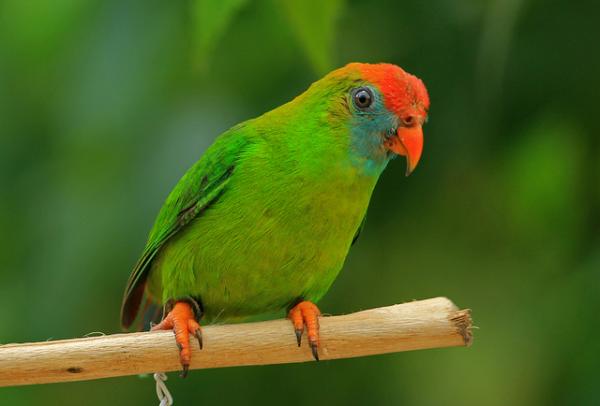Philippine Hawk-Cuckoo
by Xtian Mack on November 16, 2012The Philippine Hawk-Cuckoo (Cuculus pectoralis) is a bird belonging to the cuckoo family. It is found only in the Philippines. It was formerly classified as a subspecies of Hodgson's Hawk-Cuckoo (C. fugax) but is now commonly treated as a separate species based on differences in vocalizations.
» Read More

Philippine Hanging Parrot or Kulasisi
by Xtian Mack on November 16, 2012The Philippine Hanging Parrot (Loriculus philippensis) is also widely known as the Colasisi, taken from its local Tagalog name, "Kulasisi". It is a small parrot species of the Psittaculidae family. It includes about eleven subspecies, which are all native to only the Philippines; however, the exact taxonomy is unclear, and at least one of the subspecies might become split off and become a separate species if further research provides clarification. They are mainly green with areas of red, orange, yellow, and blue varying between subspecies. Only the males have a red area on their fronts, except for the population living on Camiguin, where neither male nor female have this red area. They make nests in tree holes and, unusually for a parrot, the female takes nesting material back to the nest.
» Read More
Guaiabero
by Xtian Mack on November 16, 2012The Guaiabero (Bolbopsittacus lunulatus) is a species of parrot in the Psittaculidae family, belonging to the monotypic genus Bolbopsittacus and closely related to the lovebirds (Agapornis) and hanging parrots (Loriculus). It is endemic to the Philippines. Its common name is derived from its reputation for eating guavas.
» Read More

Mindanao Lorikeet
by Xtian Mack on November 16, 2012The Mindanao Lorikeet is about 20 cm (8 in) long. It is mainly green with yellow transverse striations on its front. Its face is red and there is a dark purple band around its head. There is extensive yellow areas on the lower surface of its wings. Its legs are greenish-grey. The beak is orange, the eye-ring is dark grey, the irises are red. Male and female are identical in external appearance. Juveniles have less red on their faces and the purple headband is replaced with a brownish area behind the eye, their eye-rings are pale grey, their irises are brown, and the beak is dark brown.
» Read More
Philippine Green Parrot
by Xtian Mack on November 16, 2012The Blue-naped Parrot (Tanygnathus lucionensis), also known as the Blue-crowned Green Parrot, Luzon Parrot, the Philippine Green Parrot, and locally known as Pikoy, is a parrot found throughout the Philippines including the Talaud Islands and islands off north and east Borneo (with introduced population in Borneo itself, e.g. Kota Kinabalu). It is a medium size parrot (31 cm), primarily green except for a light blue rear crown and nape, pale blue lower back and rump, scalloped shoulders with orange-brown on black coverts, and blackish underwings with green underwing coverts.
» Read More

Philippine Cockatoo or Kalangay
by Xtian Mack on November 15, 2012The Philippine Cockatoo or Kalangay, or Red-vented Cockatoo (Cacatua haematuropygia), is a critically endangered species of cockatoo that is endemic to the Philippines. It is roughly the size and shape of the Tanimbar Corella, but is easily distinguished by the red feathers around the vent.
» Read More

Luzon Bleeding-heart Dove
by Xtian Mack on November 15, 2012The Luzon Bleeding-heart (Gallicolumba luzonica) is one of a number of species of ground dove in the genus Gallicolumba that are called "bleeding-hearts." They get this name from a splash of vivid red color at the centre of their white breasts. The Luzon Bleeding-heart is the species in which this feature is most pronounced, and on first sight it is hard to believe that the bird has not recently been wounded. A reddish hue that extends down the belly furthers the illusion of blood having run down the bird's front.
» Read More
Calayan Rail
by Xtian Mack on November 15, 2012The Calayan Rail is one of the 20 known extant flightless rails. It is small and dark brown, with a distinctive orange-red bill and legs, and utters loud, harsh calls. Its habitat seems to be restricted to forests on coralline limestone areas on Calayan and extends to a total of less than 100 km². Biologists estimate that there may be 200 pairs on the island.
» Read More
Luzon Buttonquail
by Xtian Mack on November 15, 2012The Luzon Buttonquail or Worcester's Buttonquail (Turnix worcesteri) is a species of bird in the Turnicidae family. It is endemic to the island of Luzon in the Philippines. Its natural habitat is subtropical or tropical high-altitude grassland. Locally known as "pugo," they are known to inhabit rice paddies and scrub lands near farm areas because of the availability of seeds and insects that they feed on regularly. These birds are characterized by their black heads with white spots, a brown or fawn colored body and yellow legs on males and the females are brown with white and black spots. These birds are very secretive, choosing to make small pathways through the rice fields, which unfortunately leads to their deaths as well. They are hunted by children and young men by means of setting spring traps along their usual path ways.
» Read More

Palawan Peacock-Pheasant
by Xtian Mack on November 15, 2012The Palawan Peacock-Pheasant, Polyplectron napoleonis, is a medium-sized (up to 50 cm long) bird in the family Phasianidae. It was long known as Polyplectron emphanum (Dickinson 2001). The male is the handsomest and most peacock-like member of the genus Polyplectron. It has an erectile crest, a white stripe over the eyes and highly iridescent metallic green and black plumage. The tail feathers are decorated with large blue-green ocelli, which may be spread fanlike in courtship displays. The female is smaller than the male. It has a dark brown plumage with a short crest and is whitish on the throat, cheeks and eyebrows.
» Read More
